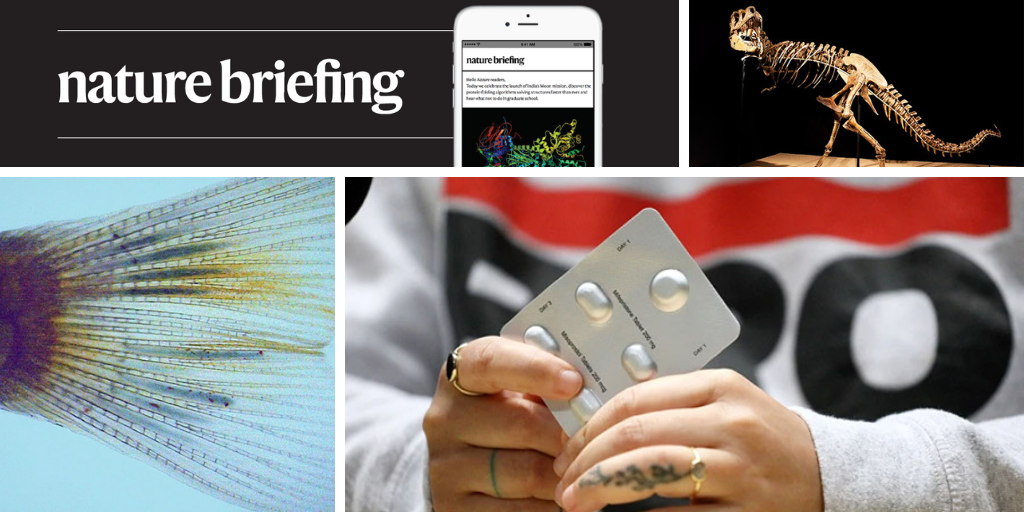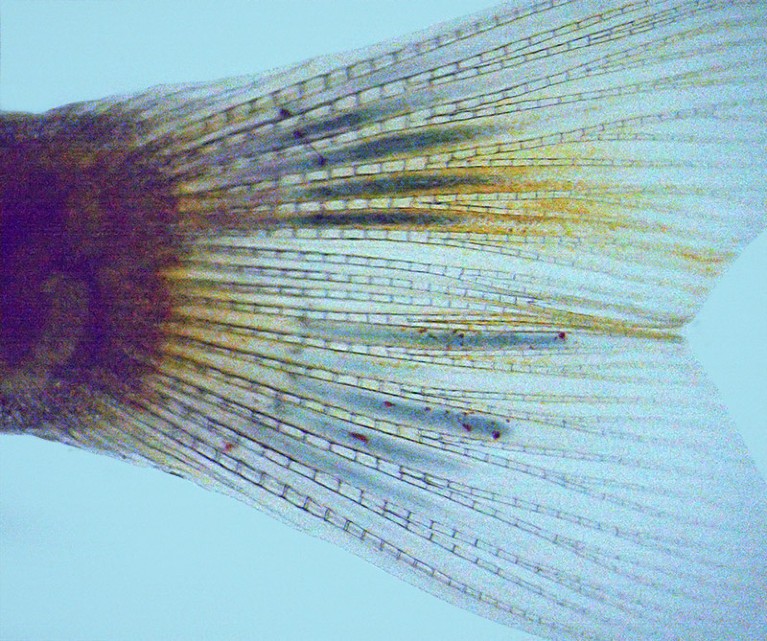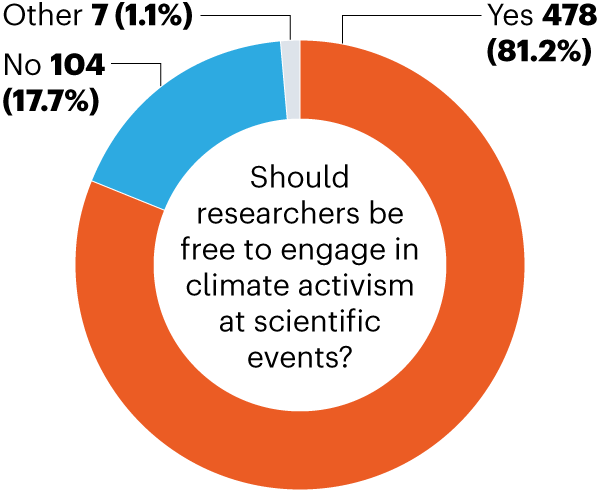Hello Nature readers, would you like to get this Briefing in your inbox free every day? Sign up here
Conductive polymers (blue) formed in the tail fins of living zebrafish.Credit: X. Strakosas et al./Science
Researchers have developed an injectable gel that transforms into a conductive polymer inside the fins and brains of living zebrafish. When injected into living tissue, the gel’s components react with the common metabolites glucose and lactate, which causes it to polymerize into a solid but flexible material. Although there is currently no way to connect these electrodes to an outside electricity source, the discovery could improve technologies for deep-brain stimulation or help damaged nerves to regrow.
Extinct theropod dinosaurs, which include iconic species such as Tyrannosaurus rex, used more than one evolutionary trick to become big: some had explosive growth spurts, whereas others grew slowly over time. Palaeontologists had always assumed that dinosaurs developed like modern birds and mammals, in which larger species grow faster during their most rapid growth period. Now, researchers who analysed growth rings in the shin bones of 42 dinosaur species have discovered that this is true for only 31% of theropods — 28% showed prolonged growth similar to that of modern crocodiles. Of the species that became smaller than their ancestors, 21% did so by shortening their growth spurts and 19% by slowing their growth.
Countries have fallen behind on their goal to slash the rate of maternal deaths this decade. For every 100,000 babies born in 2020, 223 mothers lost their lives owing to pregnancy or childbirth — a 33% drop in the maternal mortality ratio since 2000. But that number is still a long way from the target of 70 deaths per 100,000 births that countries committed to reaching by 2030 as part of the United Nations’s Sustainable Development Goals. Eight nations in particular, including Cyprus, Greece and the United States, have seen their maternal mortality ratio go up since 2000. “It is surprising that countries like the US are going so rapidly in the wrong direction,” says Mary Nell Wegner, who works in maternal and early-childhood health policy.
The UK government has quietly withdrawn £1.6 billion (US$1.9 billion) from the country’s research-and-development budget after it failed to come to an agreement with the European Union over the country’s participation in large European research projects. But the government says that the money is not lost to UK science. “Funding remains available to finalize association with EU programmes, but we have been clear that we will only pay for the periods of association,” said a government spokesperson.
Reader poll
Last week, more than 2,000 researchers asked the American Geophysical Union (AGU) to reverse the “disproportionate” actions that it took against two climate scientists who had protested at a meeting.
We asked Briefing readers whether researchers should be free to engage in climate activism at scientific events, and more than 80% of the almost 600 people who responded to our poll said yes.
Although some respondents wondered whether protesting at a scientific event would really be the most impactful way to highlight climate-change issues, many felt the protest at the AGU meeting was acceptable because it caused little disruption. Some respondents even suggested that such meetings should have a dedicated time for evidence-based activism.
Others were concerned that engaging in activism could compromise scientists’ role as objective gatherers of data — and that there are other ways to speak up. “I agree that it is the scientists’ responsibility to speak up about issues such as global warming but not as activists, but through the print medium meant for lay public, responsible public engagement and engaging with policy makers,” says bioethicist Abha Saxena.
Features & opinion
A lawsuit in Texas could restrict access to medicated abortion across the United States. The plaintiffs aim to overturn the approval of mifepristone by the Food and Drug Administration (FDA), arguing that the drug is not safe — a claim that is not corroborated by the scientific evidence, say researchers who spoke to Nature. “This really threatens the FDA’s authority over the approval process for medications across the board,” says attorney and abortion-rights advocate Amanda Allen. The plaintiffs also invoke an 1873 law that can be interpreted as a ban on sending abortion drugs through the mail. Legal specialists say that there is a good chance that the very conservative judge will rule in favour of the plaintiffs, and the case could go all the way to the Supreme Court.
A tale about the next-after-this-one pandemic — prescient when it was first drafted in 2020, and even more chilling now — is the latest short story for Nature’s Futures series.
Scientists can now watch electrons in their natural habitats as they roam around one-atom-thick materials such as graphene. The quantum twisting microscope puts two 2D layers into close contact, which allows it to view lots of surface electrons at once. The ‘twisting’ part helps researchers to look for ‘magic angles’, where stacks of slightly misaligned 2D layers can exhibit extraordinary properties, such as superconductivity. The team was surprised by how well the method worked right from the start: “It impressed even us, we weren’t expecting something so nice and so easy,” physicist John Birkbeck tells the Nature Podcast.
Nature Podcast | 29 min listen
Subscribe to the Nature Podcast on Apple Podcasts, Google Podcasts or Spotify.
Today, Leif Penguinson is hiding among the spectacular trees of Shennongjia Forestry District in Hubei, China. Can you find the penguin?
The answer will be in Monday’s e-mail, all thanks to Briefing photo editor and penguin wrangler Tom Houghton.
You could find yourself a winner if you enter EU-LIFE and Nature’s essay contest. The Utopia Institute of Research seeks your answer to the question, what does a perfect research institute look like? The authors of the three best stories, identified by an international jury of scientists and writers, will be invited, with paid travel, to present their essays at the EU-LIFE 10th Anniversary Conference in Portugal. The author of the best essay will be awarded a prize of €5,000 (US$5,300) and possible publication in Nature — two runners-up will receive €2,500 each. Find out more here.
This newsletter is always evolving — tell us what you think! Please send your feedback to [email protected].
Flora Graham, senior editor, Nature Briefing
With contributions by Katrina Krämer and Dyani Lewis
We’ve recently launched two new e-mails you might like. They’re free, and of course you can unsubscribe at any time.
• Nature Briefing: Cancer — a new weekly newsletter written with cancer researchers in mind. Sign up here to receive the next one.
• Nature Briefing: Translational Research covers biotechnology, drug discovery and pharma. Sign up here to get it free in your inbox each week.









More News
Cosmic rentals
European ruling linking climate change to human rights could be a game changer — here’s how
Lethal AI weapons are here: how can we control them?